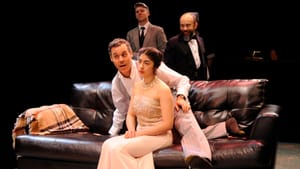Stay in the Loop
BSR publishes on a weekly schedule, with an email newsletter every Wednesday and Thursday morning. There’s no paywall, and subscribing is always free.
21st-century Eliza
Quintessence Theatre Group presents Lerner and Loewe's 'My Fair Lady'

I love that a musical premiered in 1956 based on a play written in 1913 inspired by a poem penned over 2000 years ago can be as relevant in 2017 as Quintessence Theatre Group's My Fair Lady. Director Alexander Burns's fresh production, the Germantown company's first musical in its eight seasons, highlights a contemporary news topic that isn't new: men's mistreatment of women.
The beloved story features no sexual abuse. But this tale of a linguist transforming a poor girl's life by teaching her high-class language and mannerisms shows how men often fail to acknowledge and appreciate women as independent equals. George Bernard Shaw addressed the issue in nearly all his plays, including Pygmalion (from which Alan Jay Lerner adapted My Fair Lady), and Quintessence re-focuses what Lerner and composer Frederick Loewe buried under romantic notions and beautiful songs.
Sexism, not romance
Leigha Kato's Eliza Doolittle, first encountered as a rough-talking ragamuffin selling flowers, grows in ways overlooked by most productions. While grateful for the efforts of Henry Higgins (Gregory Isaac) and Colonel Pickering (Doug Hara), she learns more than a posh accent and polite chit-chat from them. Her training starts with Higgins betting Pickering that he can transform this "squashed cabbage leaf" into a duchess within six months; inevitably, she wonders if she's their friend and colleague, or just their project.
We chuckle when Higgins asks rhetorically, "Have you ever known a man of good character where women are concerned?" But Kato's intelligent, measured Eliza realizes that being spared sexual assault does not equal respect from well-meaning yet oblivious men. These include her father, Alfred (Bradley Mott), who wants compensation for her from Higgins, and well-born suitor Freddy (Lee Cortopassi), who places her on a pedestal.
When she finally rebels, it's not just a girlish tantrum, as others typically play the role. Kato's Eliza is the first I've seen in My Fair Lady who re-defines her terms instead of meekly submitting to Higgins; she's also the first in my experience resembling Shaw's Eliza, whom the playwright deliberately did not romantically entangle with Higgins. Kato played the title role in Shaw's Saint Joan at Quintessence, and retains her defiance and intelligence. Isaac's amiably obtuse Higgins -- thankfully no Roy Moore, more a manchild akin to The Big Bang Theory's Sheldon Cooper -- is no match for her.
Song and dance
Quintessence's chamber version showcases the musical's many memorable songs well. The un-miked performers sing ably, especially Kato. Music director Christopher Ertelt and Amanda Morton play pianos set at the stage's ends. Doug Greene's set runs across the space with audience on two sides, allowing for quick changes but providing little spectacle, though David Sexton's colorful lighting helps.
Choreographer Kaki Burns keeps the action lively despite the challenges of singing and dancing to opposite sides simultaneously. Director Burns, however, has characters jumping awkwardly on sofa, chairs, and tables, which one of my favorite teachers derides as "the last refuge of desperate directors."
This two-piano version eliminates the chorus, resulting in many quick changes for its 10 actors playing multiple roles. Costume designer Christina Bullard helps by putting the circa 1910 London characters in modern dress, freeing characters, especially Eliza, from confining period costumes. It also allows for more vivid contrast between Eliza's lower-class youth and Higgins's high-born stuffiness, which the diverse casting and suggestions of gay characters also support. Bullard still provides finery, with eye-popping floral fascinators on the aristocratic women's heads in the Ascot scene, and hip-hop trappings for Doolittle and his drinking pals.
Alexander Burns adds an extra element to the long musical, a dumbshow of Ovid's "Pygmalion" from Metamorphoses during the overture. I'm not sure anyone who doesn't know Pygmalion or My Fair Lady will understand, but it provides context, and starts the familiar show with intrigue. We've progressed since that source material, which doesn't consider the woman's independent identity at all -- but we still have a long way to go.
What, When, Where
My Fair Lady. By Alan Jay Lerner and Frederick Loewe, based on Pygmalion by George Bernard Shaw, Alexander Burns directed. Quintessence Theatre Group. Through December 30, 2017 at the Sedgwick Theater, 7137 Germantown Avenue, Philadelphia. (215) 987-4450 or quintessencetheatre.org.
Sign up for our newsletter
All of the week's new articles, all in one place. Sign up for the free weekly BSR newsletters, and don't miss a conversation.
 Mark Cofta
Mark Cofta